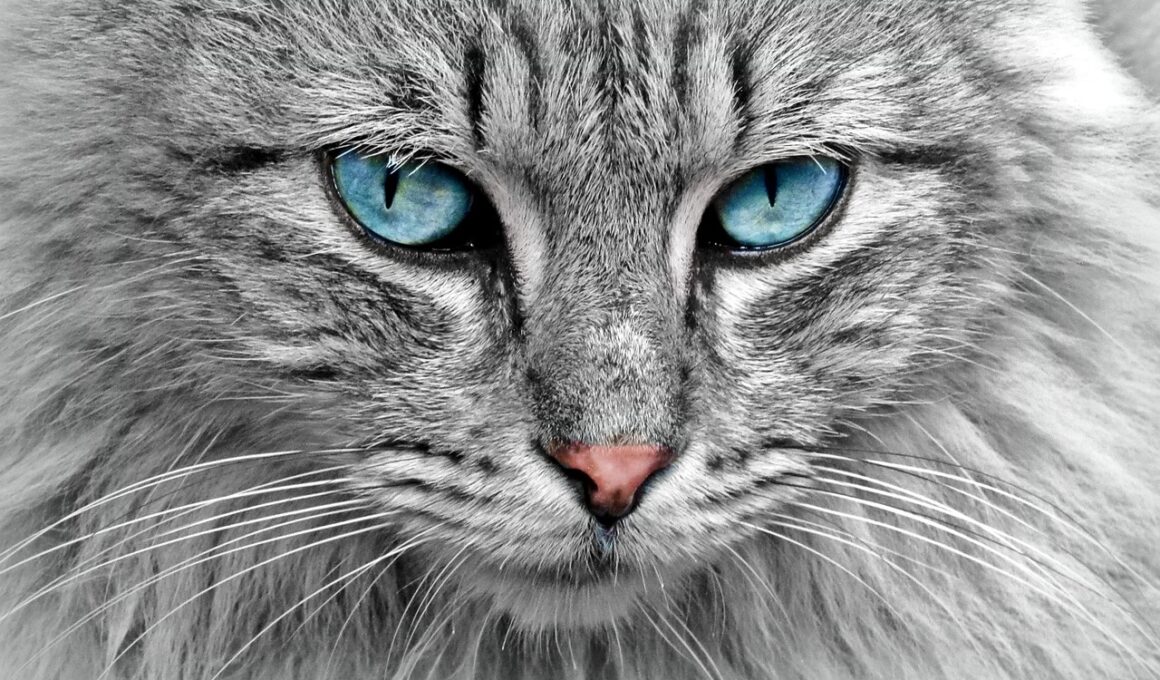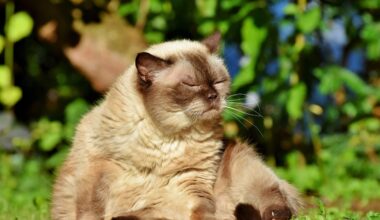Toys and Activities to Keep Your Cat Engaged and Away from Pica
Keeping your cat occupied is crucial, especially when dealing with pica, a behavior where cats eat non-food items. Engaging toys can help distract and redirect your cat’s instincts to chew on inappropriate items. Interactive toys like feather wands or laser pointers can stimulate your cat physically and mentally. Providing such toys encourages playtime and diversion from chewing on harmful materials. Cat puzzle toys also hold great potential since they offer rewards when your cat manipulates them correctly. Try different toys to find out which ones your cat enjoys the most. A variety of engaging activities keeps boredom at bay, reducing pica risks. Another great idea is to create an obstacle course with boxes, tunnels, and climbing furniture. This option satisfies a cat’s natural instincts to explore and play. Regular play sessions help not just to bond with your cat but also to combat pica through physical activity. Remember to rotate toys regularly so they stay fresh. Keeping your cat engaged is essential for preventing undesirable behaviors, aiming for a harmonious living environment together with your pet.
Providing new experiences is another way to keep your cat engaged and reduce pica. Cats enjoy varying textures and sounds, so introducing them to different environments or items can stimulate their senses. Consider safe and appropriate materials like cardboard boxes, paper bags, or fabric swatches, which can excite your cat. Any activity that piques their curiosity without posing danger is beneficial. You can also increase their interaction with these materials by hiding treats inside them for a fun scavenger hunt. This method reinforces the idea that play can yield positive rewards. Regularly changing the layout of their environment, such as moving furniture or toys, can also maintain their interest. Consider offering blankets or bedding in different textures. Make sure they can retreat to areas that are comfortable yet stimulating. Additionally, many prepare sensory activities by using catnip toys, which many cats find captivating. Allowing access to vertical spaces also encourages exploration, fulfilling their natural instincts. With some creativity, the environment can encourage them to play instead of munching on inappropriate items. The closer you get to understanding your cat’s preferences, the better you can cater to their individual needs.
Engagement Through Mental Stimulation
Mental stimulation is as important as physical activities for your cat. Engaging their minds can help reduce anxiety and the urge to chew on non-food items. Interactive toys designed for cats, like treat-dispensing puzzles, can provide mental challenges. These toys require the cat to think critically and work to retrieve a treat, promoting cognitive function. The satisfaction of solving such puzzles can deter them from engaging with harmful items. Also, consider teaching your cat tricks. Cats can learn commands or even complex behaviors through positive reinforcement training techniques. Sessions can be brief yet rewarding, maintaining your cat’s focus and interest. Incorporating play therapy or sensory activities is also beneficial. Things like crinkly material or toys that mimic prey movement can enhance their experience. Encouraging socialization with other pets, if feasible, can enrich their lives and reduce loneliness and boredom. To add to the mental exercise, use scratching posts or climbing trees; these activities allow exploring and climbing instincts. Fostering a stimulating environment can greatly improve your cat’s behavior and emotional wellbeing while keeping the risk of pica in check.
You can also utilize homemade toys as a cost-effective solution to keep your cat entertained. Cats love to chase after simple items, like scrunched-up paper balls or string tied to a stick. Even old socks filled with catnip can become instant hit toys. Make sure that the items you use are safe, without any choking hazards. You might also craft DIY feather toys; simply attach feathers to a stick using sturdy string. This brings an element of surprise in play, engaging their hunting instincts effectively. Ensure you’re always supervising playtime, especially with homemade toys, to avoid any unforeseen accidents. Regularly check your cat’s toys for wear and tear as safety remains a top priority. Rotate these homemade toys to prevent your cat from getting bored with the same items. Explore different shapes and materials to see what excites your pet. The more diverse the options, the less temptation there will be to seek out inappropriate objects. Those creative solutions can forge a bond between you and your cat. Keeping playtime fun and safe not only enhances engagement but also promotes your cat’s mental and physical health.
Outdoor Engagement Opportunities
For those who feel comfortable, outdoor activities can provide remarkable stimulation for your cat. If you have a safe enclosed yard, you can supervise your cat while they explore the grass and plants. Exploring nature often increases their engagement with their surroundings. Some cats even enjoy walking on a leash or in a pet stroller. Training your cat to walk on a leash opens up new horizons and opportunities for exploration while maintaining safety. Leash training can be gradual; begin in a familiar environment before venturing into more stimulating areas. Offer plenty of praise and treats as they adapt. To enhance this experience, consider installing an outdoor catio, ensuring your cat feels secure while enjoying fresh air. These areas can be furnished with climbing structures or lounging pads. Spending time outside allows cats to release pent-up energy naturally. Whether through safe access or direct supervision, outdoor experiences can empower your cat. By enriching their environment, you’re providing alternatives to pica behaviors. A blend of indoor and outdoor enrichment is ideal for your cat’s overall well-being.
Creating a routine also plays a vital role in keeping your cat entertained and minimizing pica occurrences. Cats thrive on consistency and knowing what to expect in their daily lives. Establishing a play schedule helps your cat anticipate active times. Incorporate various activities throughout the week, including puzzle games, playtime with interactive toys, and supervised outdoor exploration. This familiar structure can significantly minimize boredom and its associated problems. You could also engage your cat in quiet play sessions; for instance, quiet time spent brushing or petting can be soothing. Incorporating scheduled feeding times with engaging activities can create positive associations with mealtime. Track your cat’s reaction to different activities to tailor a personalized routine. This routine doesn’t have to be rigid, but it provides a general guideline. Cats adapt well to routines, providing security and reducing anxiety-related behaviors, such as pica. Remember, patience is key. Each cat is unique, with different preferences, so refining the routine involves trial and error as well. Create a balance that keeps your cat both mentally and physically stimulated throughout their day.
Conclusion: Long-Term Engagement Strategies
Long-term strategies for managing pica in your cat require ongoing commitment and creativity in providing engagement. As you explore new toys, activities, and environments, actively observe what resonates with your pet. Engagement is not only about keeping them occupied; it’s also about understanding their needs and preferences precisely. Always monitor the items they choose to engage with, ensuring nothing harmful is within reach. Establishing a bond through play fosters trust between you and your cat as you navigate issues related to pica. Remember the importance of regular vet check-ups, as they can offer insights and advice tailored specifically for your cat’s behavior. Maintaining an enriching environment requires a diverse approach involving routines, various materials, and active participation. Cats value both independence and interaction; ensuring that your cat’s emotional needs are met will naturally deter pica behaviors. Above all, remain flexible and adapt your strategies as necessary. Celebrate small victories and appreciate the moments spent bonding with your feline friend. Adequate engagement can transform troubling behaviors, creating a happier, healthier feline companion.
Selecting the right toys and ensuring meaningful engagement is the key to combatting pica and reinforcing positive behavior. The process creates an enriching environment that fosters well-being and promotes your cat’s happiness through active play. As your cat becomes more engaged in healthy activities, you’ll observe a significant reduction in their desire to chew on non-food items. Regularly introducing new and stimulating experiences to their lives is a journey towards a fulfilling relationship. Together, you’ll create a playful atmosphere that prioritizes both fun and safety, a joyful haven for both you and your cherished companion.


